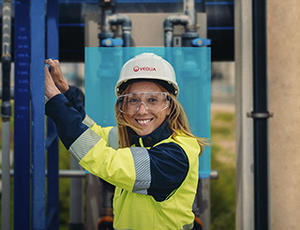What is a wastewater treatment plant?
A wastewater treatment plant (WWTP) is an industrial facility whose job is to treat influent wastewater. All human activity alters water quality, so wastewater can come from household or industrial sources or even rainwater. After being used, water is considered “polluted” and must be treated before returning to natural environments.
Wastewater treatment plants therefore play a key role in treating wastewater before it is discharged into natural areas (rivers, oceans, etc.). The main goal is to eliminate pollutants present in wastewater, including suspended solids, organic pollution, nitrogen, phosphorus and, in certain cases, pathogenic microorganisms. This process thus helps preserve the quality of water resources and ecosystems.
Water treatment step-by-step
The wastewater treatment process is generally composed of several distinct steps, each using specific technologies.
The classic process of a wastewater treatment plant, from the arrival of the water to its departure, occurs as follows:
1. Pre-treatment
Pre-treatment is the first step, during which everything that could damage equipment downstream is removed. This way, crude solid waste like branches, stones and detritus is first held back by mechanical bar screens. Sand traps and grease traps then separate sand and fats.
2. Primary treatment
Next, primary treatment aims to eliminate most suspended matter. In primary sedimentation tanks, the heaviest particles sink to the bottom while floating substances are recovered on the surface.
3. Secondary treatment
Secondary treatment, or biological treatment, is the key step in wastewater treatment. It involves degrading the dissolved organic material with the help of microorganisms that naturally occur, but in low concentrations, in the wastewater itself. However, to be able to clean the water, higher quantities are required. They are maintained in sufficient quantities in a reactor – the aeration tank – and this mix of wastewater and microorganisms is called activated sludge. In the aeration tank, microorganisms consume organic material and transform it into carbon dioxide. This step also eliminates some nutrients (nitrogen and phosphorus).
4. Separation of water and microorganisms
In order to return treated water to natural environments, it is necessary to separate water and microorganisms. This process most often occurs in a settling pond called a clarifier. Following the same principle as that of primary decanting, water remains on the surface while the sludge sinks down to the bottom. A part of this sludge is sent back to the aeration tank in order to maintain the appropriate microorganism concentration while the excess, which results from bacterial growth, is extracted and treated in what is called the sludge channel. In some cases, especially when there is a lack of space, the pair of aeration and clarifier tanks is replaced by a single structure, called a membrane bioreactor, in which the final separation step is completed using membrane filters.
5. Tertiary treatment
When the natural environment is particularly sensitive (for example in the case of a swimming area or a salmon-heavy river), tertiary treatment, or advanced treatment, may be necessary to eliminate residual pollution, including phosphates, heavy metals or organic micropollutants. Different technologies are used, including physicochemical phosphate removal, activated carbon filtration, ozone disinfection, and UV rays.
6. Sludge treatment
Finally, sludge treatment is a crucial step. Sludge, which is the result of treatment processes, contains a significant amount of organic material (the microorganisms from activated sludge) and must be recovered. In small or medium-sized facilities it is generally thickened and dehydrated mechanically, and stabilized before being used in agriculture, incinerated or put in non-hazardous waste storage facilities. In larger plants, sludge is thickened and then used to produce biogas through anaerobic digestion, which is also a way to reduce its volume. Following digestion, the residual liquid phase, or digestate, is also mechanically dehydrated and may be thermally dried for use in agriculture.

Standard-setting facilities
In France, many modern wastewater treatment plants have recently been built to meet regulatory and environmental requirements. The Achères plant in the Yvelines region of France is one of Europe’s largest and treats wastewater from the Paris area. It uses cutting edge technologies, including membrane bioreactors and ozonation, to achieve a high level of clean-up.
Elsewhere in the world, Jordan’s As Samra wastewater treatment plant treats and redistributes wastewater from the capital and surrounding areas, meeting 25% of the country’s agriculture-related water needs and 12% of overall water needs. The plant thus contributes to the development of agricultural activity and food security in Jordan, a country which lacks significant water resources, thanks to treated wastewater reuse.
Spain’s Baix Llobregat wastewater treatment plant is likewise an exemplary Veolia benchmark facility. And near the Bulgarian capital city of Sofia, Veolia modernized one of the largest wastewater treatment plants in the Balkans in 2009, once a huge consumer of electricity, by installing cogeneration systems using biogas produced by anaerobic digesters. In 2021, this produced 23,600 MWh of green energy, a 16% surplus relative to the plant’s needs, thus helping mitigate climate change’s effects while reducing dependence on costly fossil fuels.
Wastewater treatment plants play a key role in environmental protection by treating wastewater before it is discharged into natural environments. They use a mix of sophisticated technologies to eliminate pollutants and preserve the quality of water resources.
Key figures:
wastewater treatment plants managed around the world
people’s sanitation needs served by Veolia
cubic meters of wastewater treated annually




